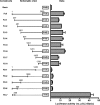Transcription of angiogenin and ribonuclease 4 is regulated by RNA polymerase III elements and a CCCTC binding factor (CTCF)-dependent intragenic chromatin loop
- PMID: 24659782
- PMCID: PMC4007445
- DOI: 10.1074/jbc.M114.551762
Transcription of angiogenin and ribonuclease 4 is regulated by RNA polymerase III elements and a CCCTC binding factor (CTCF)-dependent intragenic chromatin loop
Abstract
Angiogenin (ANG) and ribonuclease 4 (RNASE4), two members of the secreted and vertebrate-specific ribonuclease superfamily, play important roles in cancers and neurodegenerative diseases. The ANG and RNASE4 genes share genetic regions with promoter activities, but the structure and regulation of these putative promotes are unknown. We have characterized the promoter regions, defined the transcription start site, and identified a mechanism of transcription regulation that involves both RNA polymerase III (Pol III) elements and CCCTC binding factor (CTCF) sites. We found that two Pol III elements within the promoter region influence ANG and RNASE4 expression in a position- and orientation-dependent manner. We also provide evidence for the presence of an intragenic chromatin loop between the two CTCF binding sites located in two introns flanking the ANG coding exon. We found that formation of this intragenic loop preferentially enhances ANG transcription. These results suggest a multilayer transcriptional regulation of ANG and RNASE4 gene locus. These data also add more direct evidence to the notion that Pol III elements are able to directly influence Pol II gene transcription. Furthermore, our data indicate that a CTCF-dependent chromatin loop is able to differentially regulate transcription of genes that share the same promoters.
Keywords: Angiogenin; Chromatin; Promoters; RNA Polymerase; Ribonuclease; Rinonuclease 4; Transcription.
Figures











Similar articles
-
A role for CTCF and cohesin in subtelomere chromatin organization, TERRA transcription, and telomere end protection.EMBO J. 2012 Nov 5;31(21):4165-78. doi: 10.1038/emboj.2012.266. Epub 2012 Sep 25. EMBO J. 2012. PMID: 23010778 Free PMC article.
-
Specific binding sites for a pol III transcriptional repressor and pol II transcription factor YY1 within the internucleosomal spacer region in primate Alu repetitive elements.Gene Expr. 1996;6(3):151-68. Gene Expr. 1996. PMID: 9041122 Free PMC article.
-
Gene-specific repression of the p53 target gene PUMA via intragenic CTCF-Cohesin binding.Genes Dev. 2010 May 15;24(10):1022-34. doi: 10.1101/gad.1881010. Genes Dev. 2010. PMID: 20478995 Free PMC article.
-
CTCF: the protein, the binding partners, the binding sites and their chromatin loops.Philos Trans R Soc Lond B Biol Sci. 2013 May 6;368(1620):20120369. doi: 10.1098/rstb.2012.0369. Print 2013. Philos Trans R Soc Lond B Biol Sci. 2013. PMID: 23650640 Free PMC article. Review.
-
RNA polymerase III transcription - regulated by chromatin structure and regulator of nuclear chromatin organization.Subcell Biochem. 2013;61:261-87. doi: 10.1007/978-94-007-4525-4_12. Subcell Biochem. 2013. PMID: 23150255 Review.
Cited by
-
RNASE4 promotes malignant progression and chemoresistance in hypoxic glioblastoma via activation of AXL/AKT and NF-κB/cIAPs signaling pathways.Am J Cancer Res. 2024 Sep 15;14(9):4320-4336. doi: 10.62347/UDBJ5986. eCollection 2024. Am J Cancer Res. 2024. PMID: 39417186 Free PMC article.
-
DNA methylation as a mediator of HLA-DRB1*15:01 and a protective variant in multiple sclerosis.Nat Commun. 2018 Jun 19;9(1):2397. doi: 10.1038/s41467-018-04732-5. Nat Commun. 2018. PMID: 29921915 Free PMC article.
-
Associations Between Common and Rare Exonic Genetic Variants and Serum Levels of 20 Cardiovascular-Related Proteins: The Tromsø Study.Circ Cardiovasc Genet. 2016 Aug;9(4):375-83. doi: 10.1161/CIRCGENETICS.115.001327. Epub 2016 Jun 21. Circ Cardiovasc Genet. 2016. PMID: 27329291 Free PMC article.
-
ERRα Maintains Mitochondrial Oxidative Metabolism and Constitutes an Actionable Target in PGC1α-Elevated Melanomas.Mol Cancer Res. 2017 Oct;15(10):1366-1375. doi: 10.1158/1541-7786.MCR-17-0143. Epub 2017 Jun 8. Mol Cancer Res. 2017. PMID: 28596418 Free PMC article.
-
Streamlined computational pipeline for genetic background characterization of genetically engineered mice based on next generation sequencing data.BMC Genomics. 2019 Feb 12;20(1):131. doi: 10.1186/s12864-019-5504-9. BMC Genomics. 2019. PMID: 30755158 Free PMC article.
References
-
- Riordan J. F. (2001) Angiogenin. Methods Enzymol. 341, 263–273 - PubMed
-
- Subramanian V., Feng Y. (2007) A new role for angiogenin in neurite growth and pathfinding: implications for amyotrophic lateral sclerosis. Hum. Mol. Genet 16, 1445–1453 - PubMed
-
- Tello-Montoliu A., Patel J. V., Lip G. Y. (2006) Angiogenin: a review of the pathophysiology and potential clinical applications. J. Thromb. Haemost. 4, 1864–1874 - PubMed
Publication types
MeSH terms
Substances
Grants and funding
LinkOut - more resources
Full Text Sources
Other Literature Sources
Miscellaneous

